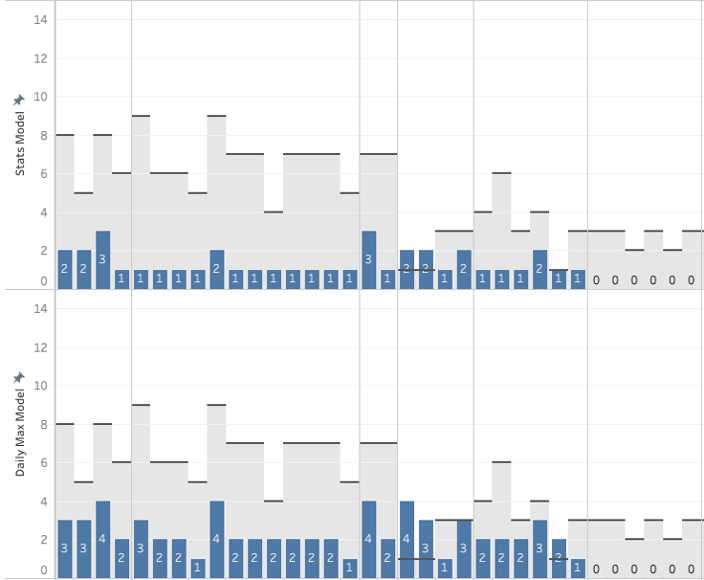Whether the focus is growing case volume without adding inventory, or supporting current business with significantly reduced stock, the strategy is the same.
Right-sizing inventory is not simple, but with advanced data analytics and automation, throughput optimization is finally within reach for healthcare providers.
With a comprehensive integrated hospital OS in place, passive data collection and advanced analytics automate and streamline inventory management bottlenecks to surgical throughput—mostly without having to effect any behavior change. Here are five of the most ways this can be accomplished:
1. Inventory Visibility
Optimizing throughput for surgeries is 100% dependent on knowing what’s on your shelf.
- How much inventory do you really need?
- Who actually owns which implants?
- What is your implant exposure?
Visibility to this data, and the capability to make that data actionable are critical to gaining the control needed to benchmark inventory and optimize surgical throughput.
Blind to the Problem
Most providers in the industry lack visibility to these numbers because case-based consignment inventory management is disconnected, manual, and cumbersome. Simply storing physical stock assumes the significant risk of securing such a volume of valuable assets. Yet everything throughout the continuum of care is a cost center—except for surgeries.
Overage Waste
In a blind effort to ensure hospitals have enough inventory on hand to support all procedures (and often being oversold to take advantage of bulk discounts), inventory is far too often grossly overstocked. This leads to tremendous waste for hospitals and MDMs alike.
Understock Risks
Conversely, coming up short for a surgery puts at risk both patient safety and future business. Worse yet, using expired or recalled product due to lack of inventory visibility presents a severe liability for providers and patients alike.
An advanced inventory automation tool will help clean up everything that’s consigned at the hospital and help maintain it: Expiring items, uncollected recalled items still sitting on a shelf, overstocked inventory—and get it where it needs to be.

Figure 1: Implants grouped by Kit showing optimized stock level (blue bar) and total quantity in stock (gray bar) for one hospital.
2. Consignment Modeling
Detailed, passively collected inventory data processed through advanced analytics allows accurate modeling of Consignment inventory processes. These data models inform inventory staff how to redistribute resources so they are always closest to where they are needed—the operating room.
Consignment Modeling measures consumption by facility and allocates assets according to facility sales. But consumption data alone does not capture the clinically required carrying costs built into each surgical technique. To make clinical sense to the vendor, traditional consumption modeling is combined with surgical grouping features such as Kits, Non-Stockable Kits, and Bundles. If the surgical grouping of product exceeds the turn goals, a single set of product is parked. Statistics are leveraged to add additional units of each SKU. As a result, the model bridges the clinical need perspective (vendor) and the financial strategy perspective (provider).

Figure 2: Sankey chart shows an example of loaner demand model-based redistribution of inventory levels.
3. Loaner Demand Modeling
Demand is the signal for loaned assets requested for surgery. It is completely distinct from consumption—rather, it is based on Demand and Volatility of Demand. As demand decreases and volatility increases, efficiency of consigned assets decreases. Parking these assets as consignment results in increased E&O spend and more expired product for providers. The stopgap solution is to migrate outlier demand to a vendor loaner pool.
More effectively, however, by tracking demand data combined with cycle time of loaned assets, modeled loaner environment enable target service levels to be achieved. This drives significant asset reductions and increased labor efficiency by rebalancing the assets to the locations they are most needed.

4. Forecasting Growth
Detailed case volume data and machine learning techniques can be leveraged to accurately predict case volumes into the future. Forecast models at the procedure and sub-procedure level, enable providers and vendors to direct their MRP systems to increase or decrease forecasted sales at the SKU and set level. Forecasts should be within 10% variance when using just 12 months of case data.
5. Streamline Order to Cash
Cumbersome and inefficient Order to Cash processes receive a complete end-to-end renewal when provider and vendor are on the same integrated healthcare operations platform. This improves accuracy, efficiency, and patient safety—while driving genuine cost savings. Pipeline Analytics are used to identify cases that are stuck in the Order-to-Cash pipeline (usually when usage is not yet confirmed or reconciled) and Behavioral Analytics are used to identify and track effectiveness of behaviors that improve the overall Order-to-Cash process. With an automated system, most reconciliation in happens automatically, and the entire Usage Capture Pipeline is monitored to quickly prioritize and resolve any delays.
Leverage Vendor-Supplier Relationships
Capacity for more surgeries improves with your ability to attract more surgeons. There are diverse reasons a surgeon might favor a particular system. However, given two comparable vendors: if you are offering a vendor which supports more surgeries per day—simply due to efficiencies in their last mile supply chain—surgeons are motivated to adopt your vendor.
Partnering with a technology company that has long-standing relationships with vendors, with experience and expertise supporting their last mile supply chain increases provider favorability among all interfacing entities.
GHX
Global giant in hospital digital integrated solutions GHX now recommends Movemedical to their provider partners, boosting their offering with digital transformation of implant management processes. From purchase to procedure to payment, GHX’s partnership with Movemedical enables simple requisitions and early pay discounts digitizing the implant request, delivery and payment process.
This partnership promotes improved outcomes for patients, increased satisfaction for staff, and significant cost savings for all stakeholders.
Solution
The Movemedical Hospital OS improves surgical throughput for health systems by benchmarking, “right-sizing” and tracking consigned medical device inventory. Tracking every movement of each piece of inventory through the course of everyday operations, Movemedical passively collects data that, leveraged intelligently, enables advanced inventory management and planning, often without even necessitating any behavioral changes.
If maximizing your facilities’ surgical throughput makes sense for your business, let’s have a conversation about it:
info@movemedical.com / call 877.469.3992
or watch this VIDEO (executive case study)
Learn More:
https://www.movemedical.com/3-data-based-methods-for-optimizing-medical-device-asset-management/

















